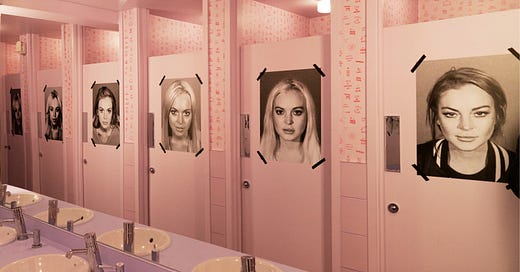I just discovered why women's toilets queues are so long
Some acts of sexism are louder than others...
Up until last week, I’d never given much thought as to why the queues for the women’s toilets are always so long.
I actually have a bit of a thing about public loos in general, to be honest. It’s the same way I feel about wet swimming pool floors. So, although I avoid them where possible, we all know, when you gotta go, you gotta go.
Ashamedly, I always put our lengthy queues down to vanity. Which makes no sense when you think about it, because even if you did use your rest break to touch up your makeup, you don’t do it in the actual cubicle.
I also just assumed we were slower than men. Surely, I’m not the only one standing in the queue thinking, ‘Come the fuck on’.
However, it wasn’t until I saw a TikTok video, that I realised I’d never questioned why we might be slower, and therefore always queuing to use the facilities.
Just the fact I only learnt this now, at 37 years old, tells you how deeply ingrained gender bias is in our world.
Rather than internally cursing the older lady in front of me or the woman with the crotch-clutching child, I should actually have aimed my frustration at the male dominated field of architecture.
The reason why our queues are so long is because public toilets were designed by men, who have no clue as to what goes on inside our cubicles.
According to this Guardian article, studies show that women take twice as long to use the toilet as men: 90 seconds vs 40 seconds. Yet, our public toilet floor space is split equally.
Not to mention the fact we take longer, is due to reasons outside of our control.
First of all, we have to undress our bottom half to use the loo for a wee. A process that takes longer than just ‘whipping’ it out.
Then there’s our shedding womb linings, which means we also might be changing a tampon or a sanitary towel while we’re in there.
Additionally, biologically, women have shorter urethas than men. We’re also more prone to urinary tract infections, which means we use the bathroom more often.
There’s also reasons outside of anatomy. Women are more likely to have young children with them, who they are also taking into the cubicle. Statistically we live longer than men, so have a larger elderly population and something else I just learnt, we’re more likely to have a disability.
The problem is, that none of this was taken into account and we were given equal floor space, when women need more. Not to mention the fact that men also have urinals, as well as cubicles.
I’d like to take this moment to apologise to all the women I have internally blamed all these years. I was wrong, I’m sorry.
To paraphrase Hugh Grant in Love Actually - if you look for it, I’ve got a sneaky feeling you’ll find that everyday acts of sexism are actually all around.






There's a brilliant book called Invisible women by Caroline Criado Perez which explains the unfortunately many similar examples (including this toilet one) on how the world is designed for men with no regards to women. It's really eye-opening how many things we take for granted in the world are simply not built for us...
Seconding Cristina’s comment. I studied with Caroline at LSE, and she is a force. The history of women’s public toilets is a fascinating aspect of suffrage.